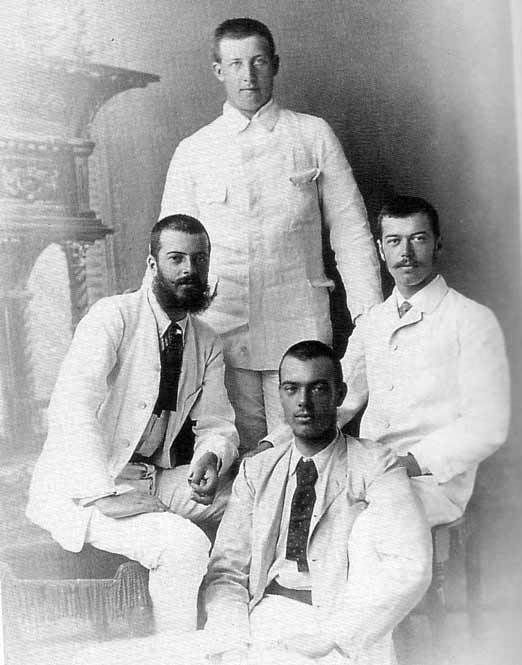#george ii of greece
Photo
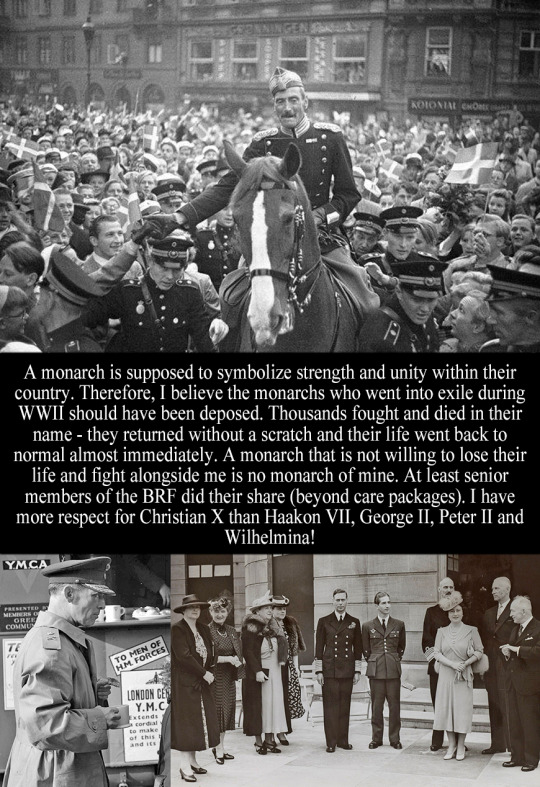
“A monarch is supposed to symbolize strength and unity within their country. Therefore, I believe the monarchs who went into exile during WWII should have been deposed. Thousands fought and died in their name - they returned without a scratch and their life went back to normal almost immediately. A monarch that is not willing to lose their life and fight alongside me is no monarch of mine. At least senior members of the BRF did their share (beyond care packages). I have more respect for Christian X than Haakon VII, George II, Peter II and Wilhelmina!” - Submitted by Anonymous
#King Christian X#Haakon VII#Peter II of Yugoslavia#queen wilhelmina#George II of Greece#british royal family#monarchy
19 notes
·
View notes
Text

Romanov relatives: The family of Prince Andrew of Greece
Prince Andrew, fourth son of Olga Konstantinovna, is seated in front with his nephew, the future King George II of the Hellenes. Behind them are Andrew's younger brother Christopher with Theodora, Andrew's wife Alice, and their daughter Margarita. Andrew and Christopher were also first cousins of Nicholas II through the Danish line.
Alice too had strong connections to the Romanov family; her mother Victoria was the elder sister of Alexandra Feodorovna and Elizaveta Feodorovna, making Alix and Ella here aunts, and OTMAA her first cousins.
#romanov relatives#greek royal family#alice of battenberg#andrew of greece#christopher of greece#george ii of the hellenes#margarita of greece#theodora of greece
72 notes
·
View notes
Text
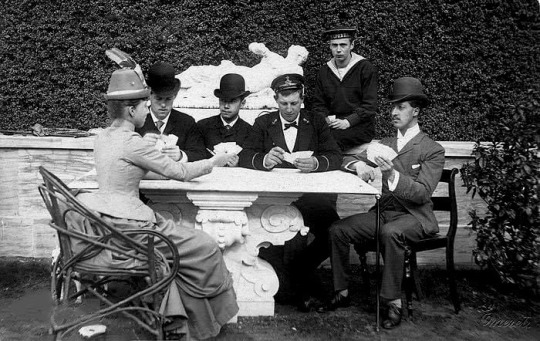
Cousins playing cards, late 1880's
Princess Alexandra of Greece and Denmark, Crown Prince Constantine of Greece and Denmark, Tsesarevich Nicholas, Prince George of Greece and Denmark, Grand Duke George Alexandrovich, Prince Albert Victor of Wales.
#alexandra georgievna#king constantine i#tsesarevich nicholas#George of Greece and Denmark#george alexandrovich#prince albert victor#1880s#danish royal family#nicholas ii#grand duke george#albert victor#alexandra of greece
45 notes
·
View notes
Text
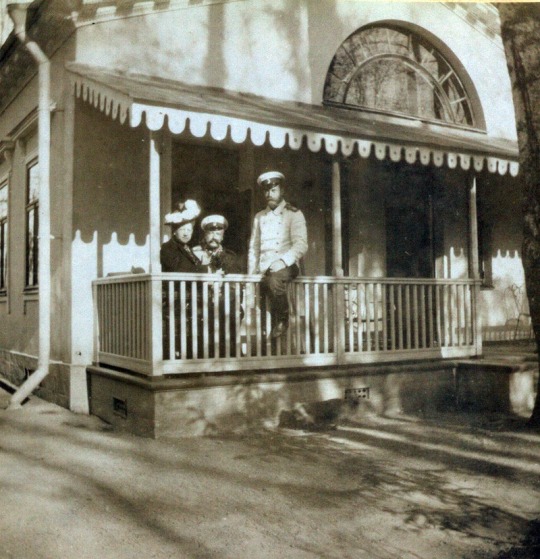
Nicholas II with Princess Maria of Greece and Grand Duke George Milhailovich.
#princess maria of greece#greece#tsar nicholas ii#grand duke george mikhailovich#tsar#my own#grand duke
23 notes
·
View notes
Text
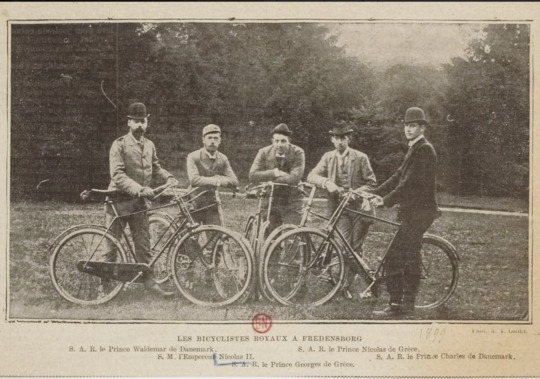
THE BICYCLE WAS ALL THE RAGE, SO THE ROYALS HAD TO GET INTO CYCLING
On the photo above, from left to right: Prince Valdemar of Denmark, Emperor Nicholas II, “Greek Georgie” (Prince George of Greece), “Greek Nicky” (Prince Nicholas of Greece) and Prince Christopher of Denmark. These guys really dressed up to go riding…neck tie, hat…
On the photo below, from left to right, Grand Duke Mikhail Alexandrovich…the jock of the group as usual, notice the handle of his bike; Cousin Victoria of Wales with an incredibly small waist, Queen Maud and her handsome and intelligent husband Hakoon VII.

#russian history#imperial russia#nicholas ii#vintage photography#prince nicholas of greece and denmark#prince george of greece#Grand Duke Mikhail Alexandrovich#Princess Victoria of Wales#Queen Maud of Norway#King Haakon VII of Norway#prince Charles of denmark
17 notes
·
View notes
Text

Rare photo of King Constantine I of Greece with his children and brother (?) (from left to right) Prince Christopher of Greece and Denmark (?), Prince George, Princess Helen, Prince Alexander of Greece and Denmark, early 1900s
Source: Princess Victoria of Wales’s private albums
#I’m not sure if the boy on the right is Christopher….#looks about right though…#king Constantine i#greek royal family#king george ii of greece#king alexander of greece#princess helen of greece and denmark#princess helen of greece#Helen queen mother of Romania#crown princess Helen of Romania#prince Christopher of Greece and Denmark
12 notes
·
View notes
Note
Hello! Was the marriage of George Mikhailovich and his wife really disastrous? Thank you.
Hello there! Thank you for your question.
Grand Duke Georgiy Mikhailovich married Princess Maria of Greece and Denkark in 1900. Upon the marriage, she became 'Maria Georgievna'. Georgiy seemed very much in love with Maria at first, he courted her for five years before she decided to marry him, having turned him down initially. They seemed to be, on paper, a good match - they were notably both very artistic, and together they designed their own English-style house in the Crimea, called Harax.

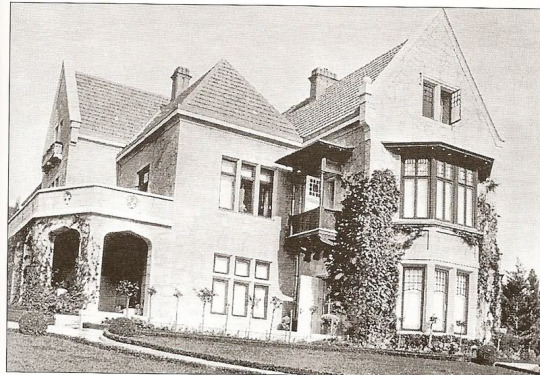
They were close with the Romanovs, especially Xenia Alexandrovna, who was Maria's best friend, cousin, AND sister-in-law! Georgiy and Maria's daughters occasionally played with Maria and Anastasia Nikolaevna, and were friendly with Nicholas and Alexandra.


Unfortunately, Maria never seemed to be able to settle in Russia and longed to return to Greece, which I suspect put strain on the marriage. The final blow (in my opinion) came in 1913, when Maria's father King George I of Greece was assassinated. It was such a shock and she was devastated. This was even more distressing as it was the Romanov Tercentenary year, and Georgiy and Maria were expected to attend celebrations, despite being deep in mourning.
Maria seemed to have been deeply unhappy, and took her children to London in 1914 as a way to take a break from the marriage, with Georgiy meant to follow them to London later on. Of course, Maria couldn't have predicted war would break out, but it meant that there was an excuse to stay in London and away from Russia where she was unhappy, as her and her daughters couldn't travel back to Russia due to the danger it posed. It is believed that her daughters, Nina and Xenia, who had tumultuous relationship with their mother, always resented her for taking them away from their father in 1914 - he would be shot in 1919, and they would never see him again after the move to London.
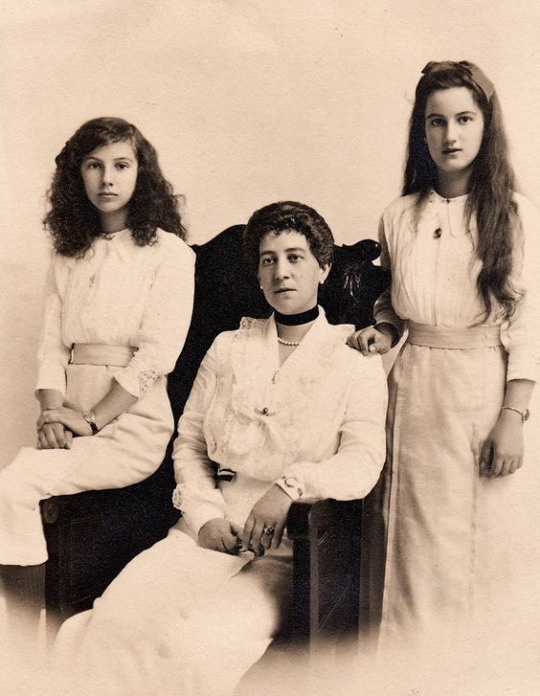
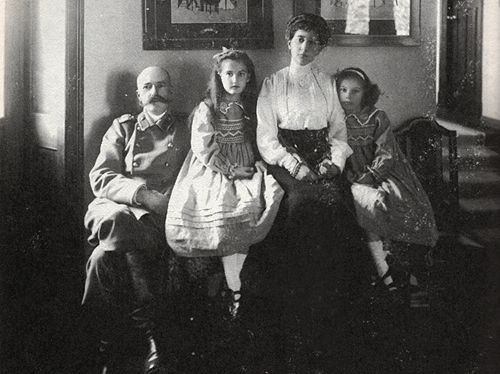
Despite this, there was clearly some affection between Georgiy and Maria. From London, Maria tried desperately to help Georgiy, contacting Russian relatives, the Danish embassy, and offering £50,000 (almost £3,000,000 today) of her own money in return for him being freed.
So, their marriage wasn't absolutely disastrous - there seems to have been some closeness and they clearly shared common interests. Their collaboration on Harax especially indicates that they had a good partnership. Despite this, Maria never seemed able to fall in love with Georgiy, or Russia. It wasn't a success by any means, but they did not hate each other.
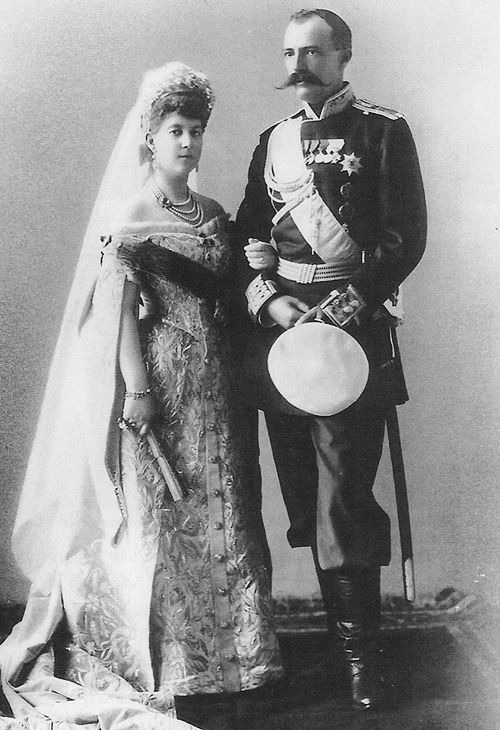
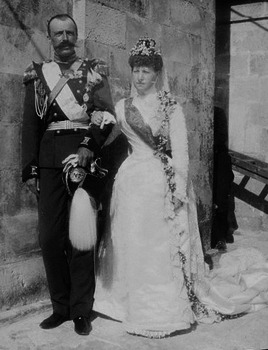
#q#anon#ask#answered#Maria Georgievna#Maria of Greece and Denmark#George Mikhailovich#Georgiy Mikhailovich#Nicholas II#Xenia Alexandrovna#Harax#Harax palace#1919#Xenia Georgievna#Nina Georgievna#Mikhailovichi
13 notes
·
View notes
Text
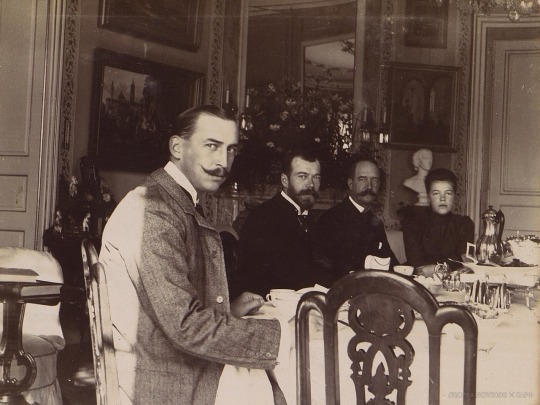
Nicholas II, his sister Olga and their European relatives: King George I of Greece and Prince Nicholas of Greece (front) at a family reunion in Denmark, 1899
29 notes
·
View notes
Text
A Royal Life by HRH Duke of Kent & Hugo Vickers #HouseofWindsor #BookReview #Audiobook
I finally got around to listening to the #Dukeofkent's memoir recently. A cousin to the late #QueenElizabethII, he has also led a life of service. Famed royal historian #HugoVickers helped put together this book. #houseofwindsor #ARoyalLife #bookreview
HRH The Duke of Kent has been at the heart of the British Royal Family throughout his life. As a working member of the Royal Family, he has supported his cousin, The Queen, representing her at home and abroad. His royal duties began when, in 1952, at the age of sixteen, he walked in the procession behind King George VI’s coffin, later paying homage to The Queen at her Coronation in 1953. Since…

View On WordPress
#A Royal Life#Duchess of Kent#Duke of Edinburgh#Duke of Kent#House of Windsor#Hugo Vickers#King George V#King George VI#Prince George#Prince Philip#Princess Marina#Princess Marina of Greece and Denmark#Queen Elizabeth II#Queen Mary
3 notes
·
View notes
Text
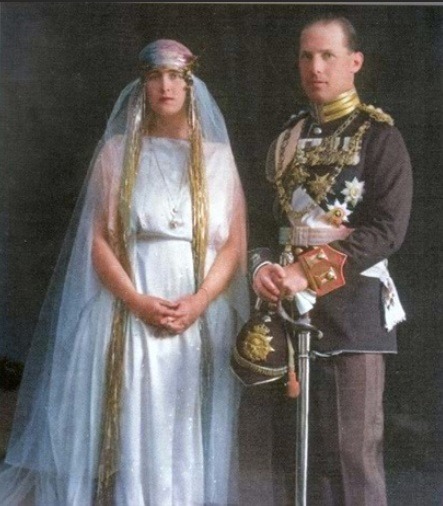
1 note
·
View note
Text
MAX & THE THREE MUSKETEERS MASTERLIST


: ̗̀°•*⁀☆ SUMMARY: mercedes is just a tiny bit worried about your dates with their archnemesis; once mick, lewis and george caught a wiff of your treason, they had to intervene and stop the villain from stealing their princess.

•*⁀☆ PAIRING: max verstappen x fem! mercedes admin! reader
╰≫ NOTE: the reader has no face claim. pictures haven't been used to represent the reader's appearance.
๋࣭ ⭑⁀☆ STATUS: completed
⋆。‧⁀☆ UPDATES: 22:00 GMT (UTC+0 UK), 09:00 AEDT (UTC+11 AUSTRALIA), 23:00 CET (UTC+1 GERMANY, FRANCE, ITALY), 00:00 EET (UTC +2 GREECE), 07:00 JST (UTC +9 JAPAN), 17:00 EST (UTC -5 AMERICA), 14:00 PST (UTC +8 CANADA), 03:30 IST (UTC +5:30)
・゚:⁀☆ TAGS: fluff, all of this reads like a fever dream, crackiest crack that has ever cracked, toto and christian being forced in-laws, max being max, this is like romeo and juliet if they slayed, blatant mick favoritism, lewis being too old for this shit, sebastian cameo, the wigs were paid actors
‧₊˚⁀☆ A/N: i was bullied to turn this into a series

[ part i ] - 20/09/2023
[ part ii ] - 22/09/2023
[ part iii ] - 25/09/2023
[ part iv ] - 30/09/2023
[ part v ] - 12/10/2023
[ the finale ] - 31/10/2023
[ bonus ] - 10/02/2024
#⚔️ max and the three musketeers#max verstappen x reader#max verstappen au#f1 x reader#f1#f1 imagine#f1 instagram au#f1 smau#f1 social media au#instagram au#social media au
2K notes
·
View notes
Text
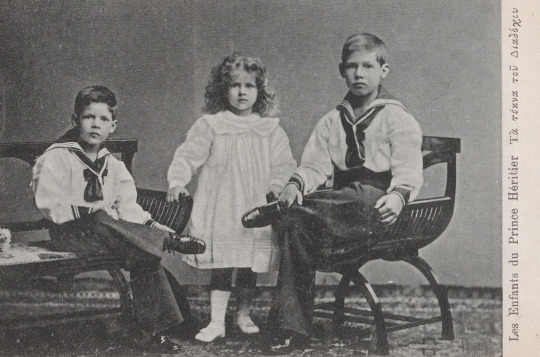
Alexander, Helen and George: eldest children of Constantine I of the Hellenes.
They were related to the Romanovs through the Konstantinovichi branch; their father Constantine was named after their great-grandfather, Grand Duke Konstantin Nikolaevich.
They were also related to OTMAA more closely through the Danish line; Nicholas II and Constantine were first cousins; Constantine's father was Maria Feodorovna's favorite brother.
#romanov relatives#greek royal family#george ii of the hellenes#alexander of greece#helen of greece#my collection
38 notes
·
View notes
Text
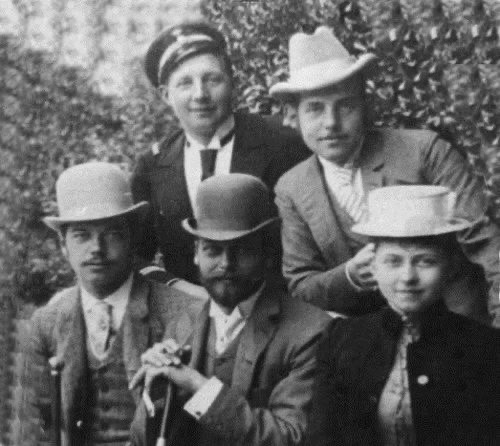
Tsesarevich Nicholas, Prince George of Wales, Princess Sophia of Prussia, Crown Prince Constantine of Greece and Prince George of Greece and Denmark 1890s.
#Tsesarevich Nicholas#prince george of wales#Princess Sophia of Prussia#crown Prince Constantine#George of Greece and Denmark#nicholas ii#George v#Queen sophia of Greece#Constantine i#1890s
35 notes
·
View notes
Note
How physically active were actually "medieval" noble women? I know is a long period but I usually see people complaning about noble women in fantasy doing stuff such as hunting or riding horses. I have seen a couple of illustrations of fencing manuals with women in them too.
We, as a culture, especially in the US, have a very bad habit of using the British Regency/Victorian era as the gold standard for how women all over the world were treated throughout history. And the truth is, it ain’t that way. It never was, because women in this exact era used to duel each other in other parts of Europe and often did it topless.
Yes, this is real. We have records of it.
Was it all women, all the time? No. Was it often enough to mention? Yes.
There’s a really good article by Kameron Hurley, “Women Have Always Fought” that goes over the history of women warriors and the laziness of specular fiction in detail. This is a particularly great few paragraphs from the article that covers where our popular conception that women don’t fight comes from.
“Women have always fought,” he said. “Shaka Zulu had an all-female force of fighters. Women have been part of every resistance movement. Women dressed as men and went to war, went to sea, and participated actively in combat for as long as there have been people.”
I had no idea what to say to this. I had been nurtured in the U.S. school system on a steady diet of the Great Men theory of history. History was full of Great Men. I had to take separate Women’s History courses just to learn about what women were doing while all the men were killing each other. It turned out many of them were governing countries and figuring out rather effective methods of birth control that had sweeping ramifications on the makeup of particular states, especially Greece and Rome.
Half the world is full of women, but it’s rare to hear a narrative that doesn’t speak of women as the people who have things done to them instead of the people who do things. More often, women are talked about as a man’s daughter. A man’s wife.
Sounds familiar, doesn’t it?
Check out some of these real women below.
Empress Maude, the daughter of the English King, Henry I, was named her father’s heir after her brother died. While her cousin Stephen stole the throne after her father’s death, she raised an army and took the country into a civil war to take it back. They fought it out for the decade it took for her son to reach adulthood, and laid the groundwork for Henry II to become king. There’s a great novel by Sharon Kay Penman, When Christ and His Saints Slept which chronicles the civil war. If you’re interested in medieval history, I recommend reading it. Her daughter-in-law, Eleanor of Aquitaine, also led an interesting life. (It should be said, real history got to the denied female heir fights for her throne before George R.R. Martin.)
There’s great videos from Xiran Jay Zhao discussing the Chinese warrior queen Fu Hao of the Shang Dynasty and Wu Zetian, who became China’s first female emperor. (Yes, you read that right. Emperor.)
There is Khutulun, the Wrestler Princess and the great-great granddaughter of Gengis Khan, who is one source of our “defeat her in battle to marry her” tropes. She issued this challenge, “defeat her in wrestling, she’ll marry.” She scammed would be suitors out of 10,000 horses. Western male authors are so threatened by Khutulun, they’ve kept trying to rewrite her history by making her fall victim to the power of love. (No, seriously.)
There’s also Hojo Masako, the Buddhist nun who deposed her own son when he proved incompetent and ruled Japan as Shogun. Here’s her wiki entry too.
The Amazons of Greek Myth were real in that they were actual Scythian women who went to war. (As Scythian women did, just like their men.) They terrified and terrorized the Greeks so much, they became immortalized in their mythology. Don’t believe me? Here’s an article from National Geographic and this one from Live Science.
There’s stories like this all throughout history from big events to small ones. (You can find more over at Rejected Princesses if you’re interested.) There are female warriors, female generals, noblewomen who took command of their husbands’ forces, widows who took to the sea to get revenge on those who wronged them, women who rode with their husbands to battle, female assassins, female leaders of rebellions, etc. The women of the Japanese samurai class were trained to fight, and fight they did. Women warriors, queens, and politicians are all over mythology too. You’ll often see these women come out of the upper echelons of society because money creates options, but they are there. Many of those stories are lost to history, in some cases purposefully, and there was a long trend among archeologists that assumed because a person was buried with male grave goods, the body had to be male. We’re now finding out that isn’t true. There’s a significant portion of warrior corpses that have turned out to be female. Assassin’s Creed: Valhalla chose to post a notice about it in response to these exact criticisms you’re questioning.
Those people you see complaining online? They’re clinging to a version of history that doesn’t exist. More, we know it doesn’t, because popular culture is hungry to the point of desperate for aggressive, confident, and competent female characters. If they were truly a lie, they wouldn’t ring true for so many people.
The history we’re taught today largely downplays women’s achievements, contributions, and successes while uplifting those of men. It’s a fact. Go look at famous female figures anywhere, you’ll find the same story at play over and over. Historically, fantasy as a genre largely portrays a world that is, in fact, fantasy, but that fantasy has nothing to do with women doing things they’re not “supposed” to. There’s no clubhouse. There’s nothing unrealistic in imagining your female character is a kickass queen who defeats overconfident men in wrestling competitions and robs them of all their horses. It’s not unrealistic to come up with an ending that doesn’t conclude in tragedy, violent deaths, them “learning their place,” or even locked within the bonds of an unhappy marriage. (Shocker!) Some did, but the truth isn’t universal. It’s not even unrealistic to imagine they might have supportive male family members, love interests, and followers who happily (gasp) assist them in these endeavors. Maude, for reference, had bastard half-brothers who helped her instead of trying to take the throne for themselves.
History got here before fantasy authors. There’s nothing unrealistic about reality. Popular conceptions and common knowledge fed to us by the majority male dominated culture isn’t always the truth. Reality is, it’s the stories we see normalized across the media spectrum that are wrong. The ones that insist women are objects, who commodify their pain, and reframe their stories to ensure the focus remains on men. While this is changing, women are still often treated as the NPCs of male driven stories.
The people you hear complaining? They want storytelling traditions to stay that way, for the Great Man values countless narratives have reinforced to remain unchallenged. Funny as it sounds, they’re threatened by the very existence of narratives that countermand that centralized focus on men being superior, that there is a stratified gender hierarchy, and men taking their place as the sole, worshipful focus of a woman’s existence, much less these female characters being important in their own narratives. If these people weren’t threatened by female characters being people, they wouldn’t say anything. They’d just move on in apathy.
Reality is people are complicated. There’s room for all stripes in all colors and contexts. It’s no secret that history has suppressed and erased countless stories that don’t support the ruling narrative of the dominant culture. These same people forget there’s plenty of storytelling traditions that include women taking their place as warriors in cultures outside America. For all the sexism and misogyny, women fighting is not an alien concept, it’s not even foreign to other Western European traditions.
Believe what your own research is showing you, not what a bunch of idiots who can’t tell their ass from their elbow are whining about. They can’t handle someone who isn’t straight, male, and (most often) white being the central focus. Really, they can’t handle these characters as even a side focus. That’s their loss, it doesn’t have to be yours.
-Michi
This blog is supported through Patreon. Patrons get early access to new posts, and direct access to us through Discord. If you’d like to support us, please consider becoming a Patron.
4K notes
·
View notes
Text
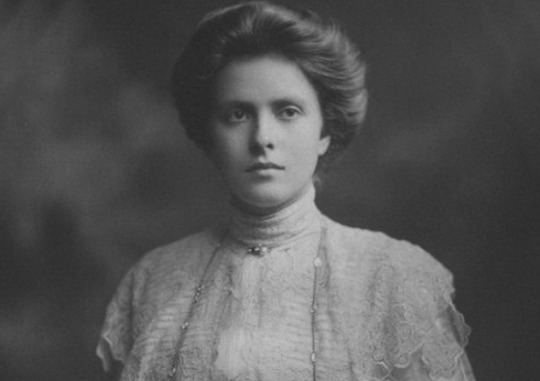
THURSDAY HERO: Princess Alice
Amazing story! Princess Alice was an unconventional royal who prioritized helping others over wealth and privilege. She devoted her life to good deeds and spiritual growth, and was notable among European royalty for taking Jews into her home during the Holocaust.
Princess Alice stood out for another reason: she was deaf from birth.
Born in 1885 at Windsor Castle, Alice was the great-granddaughter of Queen Victoria. She learned to lip read at a young age, and could speak several languages. Alice was widely regarded as the most beautiful princess in Europe.
At age 17, Alice fell in love with dashing Prince Andrew of Greece and they were married in 1903. Alice and Andrew had four daughters and a son. Their son Philip would later be married to Queen Elizabeth II. Alice communicated with her children mainly in sign language.
Political turmoil in Greece forced the royal family into exile. They settled in a sleepy suburb of Paris, where Alice threw herself into charitable work helping Greek refugees. Her husband left her for a life of gambling and debauchery in Monte Carlo.
Relying on the charity of wealthy relatives, Alice found strength in her Greek Orthodox faith. She became increasingly religious, and believed that she was receiving divine messages and had healing powers. She yearned to share her faith and mystical experiences with others, but instead was dismissed as mentally unhinged.
Alice had a nervous breakdown in 1930. She was committed against her will to a mental institution in Switzerland, with a dubious diagnosis of schizophrenia. Alice did not even get a chance to say goodbye to her children. Her youngest, 9 year old Philip, returned from a picnic to find his mother gone.
Alice tried desperately to leave the asylum, but was kept prisoner in Switzerland for 2 1/2 years. During that time, her beloved son Philip was sent to live with relatives, and her four daughters married German princes. Alice was not allowed to attend any of their weddings.
Finally, in 1932, Alice was released. She became a wanderer, traveling through Europe by herself, staying with relatives or at bed & breakfast inns. In 1935, Alice returned to Greece, where she lived alone in a modest two bedroom apartment and worked with the poor.
The Germans occupied Athens in April 1941. Alice devoted herself to relieving the tremendous suffering in her country. She worked for the Red Cross, organizing soup kitchens and creating shelters for orphaned children. Alice also started a nursing service to provide health care to the poorest Athenians.
In 1943, the Germans started deporting the Jews of Athens to concentration camps. Alice hid a Jewish widow, Rachel Cohen, and her children in her own apartment for over a year. Rachel’s late husband, Haimaki Cohen, was an advisor to King George I of Greece, and Alice considered it her solemn duty to save the remaining Cohen family.
Alice lived yards from Gestapo headquarters. When the Germans became suspicious of her and started asking questions, she used her deafness as an excuse not to answer them. Alice kept the Cohen family safe until Greece was liberated in 1944.
After the war, Alice founded her own religious order, the Christian Sisterhood of Martha and Mary, and became a nun. She built a convent and orphanage in a poverty-stricken part of Athens. Alice dressed in a nun’s habit consisting of a drab gray robe, white wimple, cord and rosary beads – but still enjoyed smoking and playing cards.
In 1967, after a Greek military coup, Alice finally returned to Great Britain. She lived at Buckingham Palace with her son Philip and daughter-in-law, Queen Elizabeth II.
Alice died in 1969. She owned no possessions, having given everything to the poor. Before she died, Alice expressed a desire to be buried at the Convent of Saint Mary Magdalene on the Mount of Olives in Jerusalem, but instead was laid to rest in the Royal Crypt in Windsor Castle.
In 1988, almost 20 years after she died, Alice’s dying wish was finally granted. Her remains were sent to Jerusalem, where she was buried on the Mount of Olives.
In 1994, Alice was honored by the Holocaust Memorial in Jerusalem (Yad Vashem) as Righteous Among The Nations. Her son Prince Philip said of his mother’s wartime heroism, “I suspect that it never occurred to her that her action was in any way special. She was a person with a deep religious faith, and she would have considered it to be a perfectly natural human reaction to fellow beings in distress.”
Video
138 notes
·
View notes
